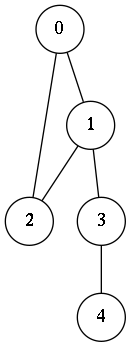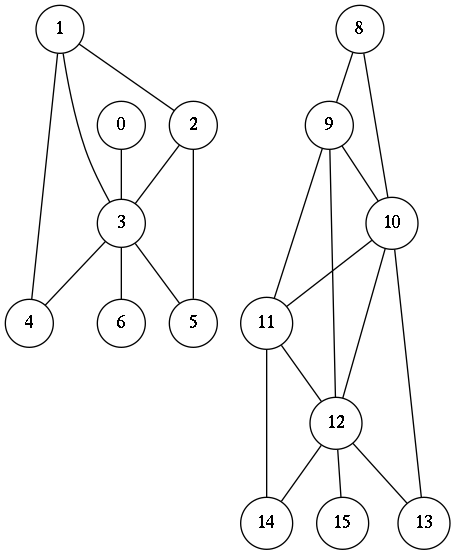Eigen-values of the Laplacian and Connected Components of a Graph
Description of the problem
This post is inspired by a post I saw at John D. Cook’s blog. John observes that the second smallest eigen-value of the Laplacian gives us important information about the connectivity of the graph. The eigen-values tell more, of course. See for example Fan Graham’s excellent survey on the subject.
Today, I will write my implementation of the experiment on testing the second smallest eigen-value of the Laplacian of a graph in common lisp.
Implementation
First, I am going to need two utility thunks: the first is a macro,
(defmacro -> (x &rest forms)
(dolist (f forms x)
(if (listp f)
(setf x (append (list (car f) x) (cdr f)))
(setf x (list f x)))))
->while the other is a function.
(defun group-by (xs &optional (fn (lambda (x) x)))
(let (res)
(dolist (x xs res)
(let* ((y (funcall fn x))
(z (cdr (assoc y res))))
(if (null z)
(push (cons y (list x)) res)
(setf (cdr (assoc y res))
(cons x z)))))))
GROUP-BYI am going to use the threading macro -> for
compositions of functions on a single value, while I need
group-by to group values in a list using a criterion, in
this case the identity function.
I have been using the set of edges as a representation of a graph. For example:
(defvar G '((0 1) (0 2) (1 2) (1 3) (3 4)))
Grepresents the graph whose picture can be drawn as

First, let us get the list of vertices and their degrees from a given graph.
(defun degrees (G)
(mapcar (lambda (x) (cons (car x) (length (cdr x))))
(group-by (reduce #'append G) (lambda (x) x))))
DEGREESFor the graph we had above, the result is going to be
(degrees G)
((4 . 1) (3 . 2) (2 . 2) (1 . 3) (0 . 2))Next, a function that returns the Laplacian of a given graph:
(defun laplacian (G)
(let* ((degs (degrees G))
(n (1+ (reduce #'max (mapcar #'car degs))))
(res (make-array (list n n) :initial-element 0)))
(dolist (x degs)
(setf (aref res (car x) (car x)) (cdr x)))
(dolist (e G res)
(decf (apply #'aref res e))
(decf (apply #'aref res (reverse e))))))
LAPLACIANNow, let me define our experiment function:
(defun experiment (G)
(-> G
laplacian
cl-num-utils:hermitian-matrix
lla:eigenvalues
(sort #'<)
(aref 1)))
EXPERIMENTAnd our experiment
(experiment G)
0.5188056959079844d0For the next experiment, I am going to need a random disconnected graph:
(defun random-graph (n m a b)
(remove-duplicates
(loop repeat n collect
(let* ((x (+ b (random m)))
(y (+ 1 (random a) x)))
(list x y)))
:test #'equal))
RANDOM-GRAPHHere is our random graph:
(defvar H (append (random-graph 16 4 3 0)
(random-graph 25 5 3 8)))
H
And, the result of the experiment on this graph:
(format nil "~4,3f" (experiment H))
.000